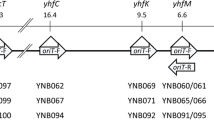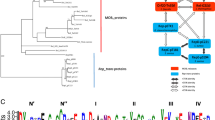Summary
The TOL plasmid pWWO gives rise to the Tol− plasmid pWWO-8 due to a specific excision event involving 40 kb of TOL DNA. This event occurs by means of reciprocal recombination involving a pair of directly repeated 1.4 kb sequences. This 40 kb segment is not involved as such in the formation in vivo of hybrid plasmids between TOL and resistance plasmids, notably RP4.
Similar content being viewed by others
References
Bayley SA, Duggleby C, Worsey MJ, Williams PA, Hardy KG, Broda P (1977) Two modes of loss of the TOL function from Pseudomonas putida mt-2. Mol Gen Genet 154:203–204
Birnboim HC, Doly J (1979) A rapid alkaline extraction procedure for screening recombinant plasmid DNA. Nucl Acid Res 7:1513–1524
Bolivar F, Rodriguez RL, Greene PJ, Betlach HC, Heynecker HL, Boyer HW, Crosa JH, Falkow S (1977) Construction and characterisation of new cloning vehicles. II. A multiple cloning system. Gene 2:75–93
Borck K, Beggs JD, Brammar WJ, Hopkins AS, Murray NE (1976) The construction in vitro of transducing derivatives of phage lambda. Mol Gen Genet 146:199–207
Campbell A (1962) Episomes. Advances in Genetics 11:101–145
Chakrabarty AM, Friello DA, Bopp LH (1978) Transposition of plasmid DNA segments specifying hydrocarbon degradation and their expression in various organisms. Proc Natl Acad Sci USA 75:3109–3122
Davis RW, Simon M, Davidson N (1971) Electron microscope heteroduplex methods for mapping regions of base sequence homology in nucleic acids. In: Grossman L and Moldave K (eds) Methods in enzymology, Vol 21. Academic Press In., New York
Depicker A, De Block M, Inzé D, Van Montagu M, Schell J (1980) IS-like element IS8 in RP4 plasmid and its involvement in cointegration. Gene 10:329–338
Downing RG, Duggleby CJ, Villems R, Broda P (1979) An endonuclease cleavage map of the plasmid pWWO-8, a derivative of the TOL plasmid of Pseudomonas putida mt-2. Mol Gen Genet 168:97–99
Downing RG, Broda P (1979) A cleavage map of the TOL plasmid of Pseudomonas putida mt-2. Mol Gen Genet 177:189–191
Ghosal D, Sommer H, Saedler H (1979) Nucleotide sequence of the transposable DNA element IS2. Nucl Acid Res 6:1111–1122
Guerry P, Leblanc DJ, Falkow S (1973) General method for isolation of plasmid deoxyribonucleic acid. J Bacteriol 116:1064–1066
Haberman P, Klaer R, Kuhn S, Starlinger P (1979) IS4 is found between eleven and twelve base pair duplications. Mol Gen Genet 175:368–373
Hansen JB, Olsen RH (1978) Isolation of large bacterial plasmids and characterisation of the P2 incompatibility group plasmids pMG1 and pMG5. J Bacteriol 135:227–238
Humphreys GO, Weston A, Brown MGM, Saunders JR (1979) Plasmid transformation of Escherichia coli. In: Glover SW and Butler LO (eds) Transformation 1978. Cotswold Press, Oxford, pp 254–279
Jacoby GA, Rogers JE, Jacob AE, Hedges RW (1978) Transposition of toluene degrading genes and expression in E. coli. Nature 274:179–180
Nakazawa T, Hagashi E, Yokota T, Ebina Y, Nakazawa A (1978) Isolation of TOL and RP4 recombinants by integrative suppression. J Bacteriol 134:270–277
Nakazawa T, Inouye S, Nakazawa A (1980) Physical and functional mapping of RP4-TOL plasmid recombinants: analysis of insertion and deletion mutants. J Bacteriol 144:223–231
Ohtsubo H, Ohtsubo E (1978) Nucleotide sequence analysis of an insertion element ISI. Proc Natl Acad Sci USA 75:615–619
Sommer J, Cullum J, Saedler J (1979) Integration of IS3 into IS2 generates a short sequence duplication. Mol Gen Genet 177:85–89
White GP, Dunn NW (1977) Apparent fusion of the TOL plasmid with the R91 drug resistance plasmid in Pseudomonas aeruginosa. Aust J Biol Sci 30:345–355
Willetts NS, Crowther C, Holloway BW (1981) The insertion sequence IS21 of R68.45 and the molecular basis for mobilization of the bacterial chromosome. Plasmid 6:30–52
Williams PA, Murray K (1974) Metabolism of benzoate and the methylbenzoates by Pseudomonas putida (arvilla) mt-2: evidence for the existence of a TOL plasmid. J Bacteriol 120:416–413
Worsey MJ, Williams PA (1975) Metabolism of toluene and xylenes by Pseudomonas putida (arvilla) mt-2: evidence for a new function of the TOL plasmid. J Bacteriol 124:7–13
Author information
Authors and Affiliations
Additional information
Communicated by E. Bautz
Rights and permissions
About this article
Cite this article
Meulien, P., Downing, R.G. & Broda, P. Excision of the 40kb segment of the TOL plasmid from Pseudomonas putida mt-2 involves direct repeats. Molec. Gen. Genet. 184, 97–101 (1981). https://doi.org/10.1007/BF00271202
Received:
Issue Date:
DOI: https://doi.org/10.1007/BF00271202




